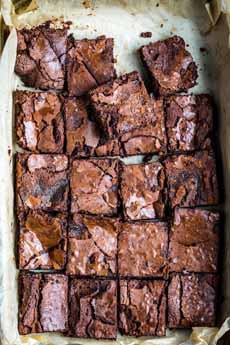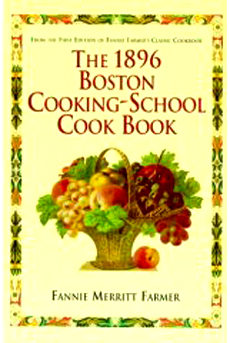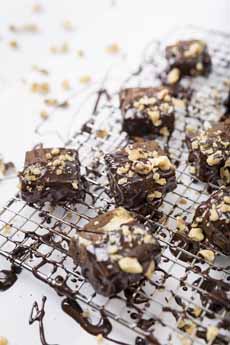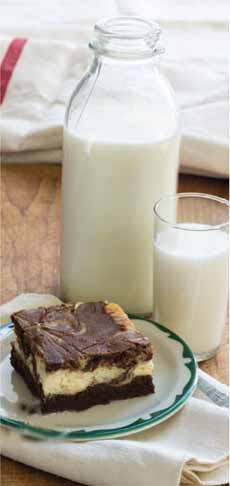Alas, that theory relies on a cookbook published in Bangor in 1912, six years after the first chocolate brownie recipe was published by one of America’s most famous cookbook authors, Fannie Merritt Farmer, in 1906 (and the Bangor version was almost identical to the 1906 recipe).
The actual “inventor” will most likely never be known, but here’s what we do know: Sources: Not Always Correct
Quite a few sources cite the first-known recipe for brownies as the 1897 Sears, Roebuck Catalogue, but this was a recipe for a molasses candy merely called brownies. The name honored the elfin characters featured in popular books, stories, cartoons and verses at the time by Palmer Cox; the Eastman Kodak Brownie camera was also named after these elves.
This recipe is an early, less rich and chocolaty version of the brownie we know today, utilizing two squares of melted Baker’s chocolate. The recipe proportions are similar to her 1896 chocolate cookie recipe, except that the brownie recipe uses substantially less flour and calls for baking the batter in a seven-inch square pan.
What About Bangor Brownies?
The second brownie recipe, appearing in 1907, was in Lowney’s Cook Book Illustrated,* written by Maria Willet Howard and published by the Walter M. Lowney Company of Boston. Ms. Howard, a protégé of Ms. Farmer, tweaked the Farmer recipe by adding an extra egg and an extra square of chocolate creating a richer, more chocolatey brownie. She named the recipe Bangor Brownies; we don’t know why.
However, this gave rise to the notion that a housewife in Bangor had invented brownies. Perhaps an unknown housewife improved upon Farmer’s recipe and this was the one published by Ms. Howard. This is discussed more thoroughly in The Oxford Encyclopedia of Food and Drink in America, which is the “Encyclopaedia Britannica” for food lovers—two volumes and 1,500 pages on the history, manufacture and marketing of food in the U.S. We’ve also included an excerpt below.†
________________ *The Lowney company manufactured chocolate and cocoa. It published numerous books, booklets and brochures to promote the use of its products. **Each square of baking chocolate is one ounce. †“The leading advocate of the Bangor theory of brownie origin was Mildred Brown Schrumpf, aptly nicknamed ‘Brownie,’ born in Bangor in 1903. Unfortunately, Mrs. Schrumpf's best piece of evidence was a Girl’s Welfare Cook Book published there in 1912. This is not only seven years post-Farmer, but the recipe contributed by Marion Oliver for Chocolate Brownies to that cookbook is almost exactly the same as the two-egg recipe for Lowney's Brownies, not Bangor Brownies. Oliver also contributed a recipe for Molasses Brownies evidently taken from the Farmer cookbook...Maria Howard may have considered the Bangor Brownies, which were to be baked in a cake pan (unlike her Lowney’s Brownies), to be descended from a recipe for Bangor Cake in Maria Parloa’s Appledore Cook Book (1872), which was a white sheet cake...In fact, the two-egg Lowney's Brownies was the recipe most often reprinted in new England community cookbooks before 1912.” —The Oxford Encyclopedia of Food and Drink in America, Andrew F. Smith editor [Oxford University Press:New York] 2004, Volume 1 (p. 136-7). ‡“The bee’s knees” is a Jazz Age idiom meaning something or someone considered extremely special. According to Mark Israel of the University of Ottowa, 1920s U.S. slang had a slew of similar phrases with the same meaning, including, but not limited to, “the cat's pajamas” and the less familiar “the eel’s ankle,” “the clam’s garter,” “the kipper’s knickers” and “the sardine's whiskers.” ________________
|

The Nibble Blog
The Latest Products, Recipes & Trends In Specialty Foods
The gourmet guide you’ve been waiting for. New food adventures are served up daily. Check it out!

Food Glossary
Our Food Directories Are "Crash Courses" In Tasty Topics
Your ultimate food lover’s dictionary packed full of information and historical references. Take a look!

Food History
Let the journey begin!
Learn about the history Of 1,000+ Favorite Foods & Beverages Let’s explore the history of your favorie goods together.Let the journey begin!




